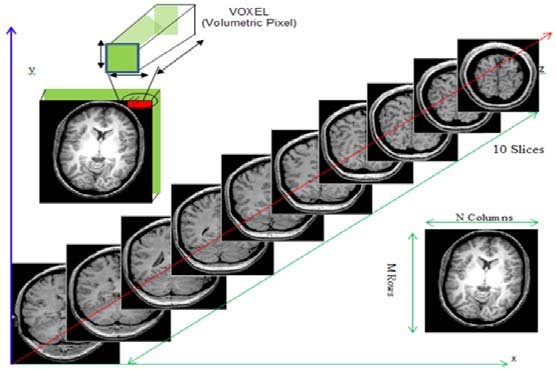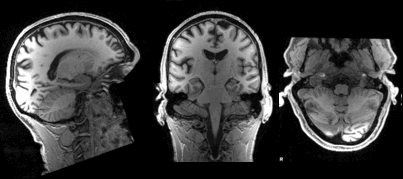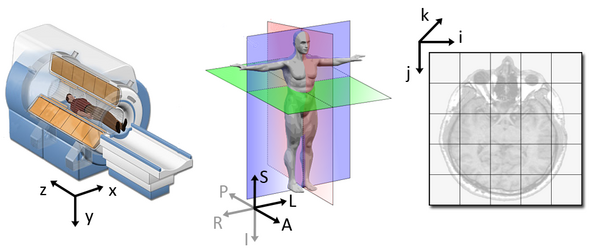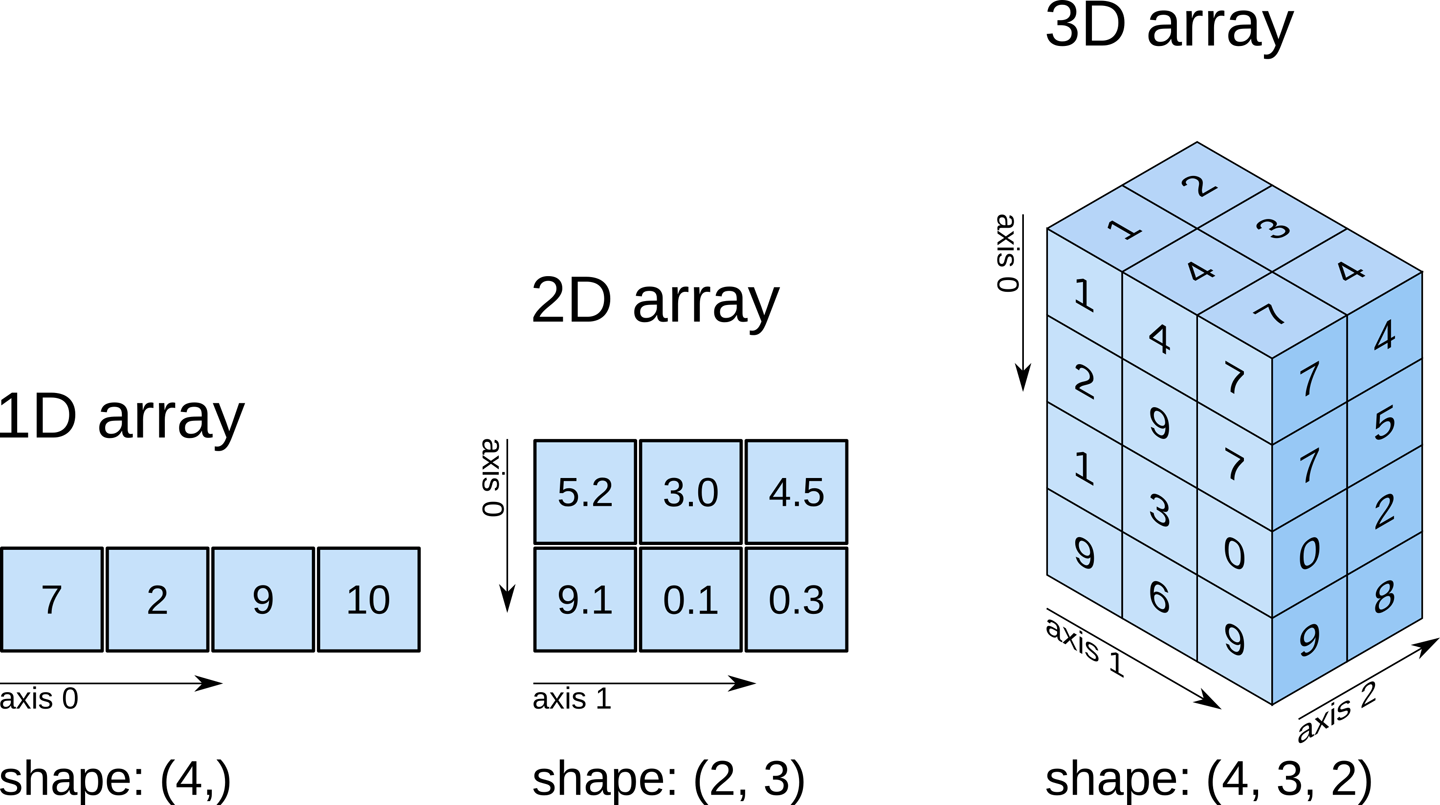Anatomy of a NIfTI
Last updated on 2025-02-26 | Edit this page
Overview
Questions
- How are MRI data represented digitally?
Objectives
- Introduce Python data types
- Load an MRI scan into Python and understand how the data is stored
- Understand what a voxel is
- Introduce MRI coordinate systems
- View and manipulate image data
In the last lesson, we introduced the NIfTI. We’ll cover a few details to get started working with them.
Reading NIfTI images
NiBabel is a Python package for reading and writing neuroimaging data. To learn more about how NiBabel handles NIfTIs, check out the Working with NIfTI images page of the NiBabel documentation, from which this episode is heavily based.
First, use the load() function to create a NiBabel image
object from a NIfTI file. We’ll load in an example T1w image from the
zip file we just downloaded.
PYTHON
t1_img = nib.load("../data/dicom_examples/nii/0219191_mystudy-0219-1114_anat_ses-01_T1w_20190219111436_5.nii.gz")Loading in a NIfTI file with NiBabel gives us a special
type of data object which encodes all the information in the file.Each
bit of information is called an attribute in Python’s
terminology. To see all these attributes, type t1_img.
followed by Tab. There are three main attributes that we’ll
discuss today:
1. Header: contains metadata about the image, such as image dimensions, data type, etc.
OUTPUT
<class 'nibabel.nifti1.Nifti1Header'> object, endian='<'
sizeof_hdr : 348
data_type : b''
db_name : b''
extents : 0
session_error : 0
regular : b''
dim_info : 0
dim : [ 3 57 67 56 1 1 1 1]
intent_p1 : 0.0
intent_p2 : 0.0
intent_p3 : 0.0
intent_code : none
datatype : uint8
bitpix : 8
slice_start : 0
pixdim : [1. 2.75 2.75 2.75 1. 1. 1. 1. ]
vox_offset : 0.0
scl_slope : nan
scl_inter : nan
slice_end : 0
slice_code : unknown
xyzt_units : 2
cal_max : 0.0
cal_min : 0.0
slice_duration : 0.0
toffset : 0.0
glmax : 0
glmin : 0
descrip : b''
aux_file : b''
qform_code : mni
sform_code : mni
quatern_b : 0.0
quatern_c : 0.0
quatern_d : 0.0
qoffset_x : -78.0
qoffset_y : -91.0
qoffset_z : -91.0
srow_x : [ 2.75 0. 0. -78. ]
srow_y : [ 0. 2.75 0. -91. ]
srow_z : [ 0. 0. 2.75 -91. ]
intent_name : b''
magic : b'n+1't1_hdr is a Python dictionary.
Dictionaries are containers that hold pairs of objects - keys and
values. Let’s take a look at all the keys. Similar to
t1_img in which attributes can be accessed by typing
t1_img. followed by Tab, you can do the same
with t1_hdr. In particular, we’ll be using a
method belonging to t1_hdr that will allow
you to view the keys associated with it.
OUTPUT
['sizeof_hdr',
'data_type',
'db_name',
'extents',
'session_error',
'regular',
'dim_info',
'dim',
'intent_p1',
'intent_p2',
'intent_p3',
'intent_code',
'datatype',
'bitpix',
'slice_start',
'pixdim',
'vox_offset',
'scl_slope',
'scl_inter',
'slice_end',
'slice_code',
'xyzt_units',
'cal_max',
'cal_min',
'slice_duration',
'toffset',
'glmax',
'glmin',
'descrip',
'aux_file',
'qform_code',
'sform_code',
'quatern_b',
'quatern_c',
'quatern_d',
'qoffset_x',
'qoffset_y',
'qoffset_z',
'srow_x',
'srow_y',
'srow_z',
'intent_name',
'magic']Notice that methods require you to include () at the end of them whereas attributes do not. The key difference between a method and an attribute is:
- Attributes are stored values kept within an object
- Methods are processes that we can run using the object. Usually a method takes attributes, performs an operation on them, then returns it for you to use.
When you type in t1_img. followed by Tab,
you’ll see that attributes are highlighted in orange and methods
highlighted in blue.
The output above is a list of keys you can use from
t1_hdr to access values. We can access the
value stored by a given key by typing:
Extract values from the NIfTI header
Extract the value of pixdim from t1_hdr
2. Data
As you’ve seen above, the header contains useful information that
gives us information about the properties (metadata) associated with the
MR data we’ve loaded in. Now we’ll move in to loading the actual
image data itself. We can achieve this by using the method
called t1_img.get_fdata().
OUTPUT
array([[[ 8.79311806, 8.79311806, 8.79311806, ..., 7.73574093,
7.73574093, 7.38328189],
[ 8.79311806, 9.1455771 , 8.79311806, ..., 8.08819997,
8.08819997, 8.08819997],
[ 9.1455771 , 8.79311806, 8.79311806, ..., 8.44065902,
8.44065902, 8.44065902],
...,
[ 8.08819997, 8.44065902, 8.08819997, ..., 7.38328189,
7.38328189, 7.38328189],
[ 8.08819997, 8.08819997, 8.08819997, ..., 7.73574093,
7.38328189, 7.38328189],
[ 8.08819997, 8.08819997, 8.08819997, ..., 7.38328189,
7.38328189, 7.03082284]],
[[ 8.79311806, 9.1455771 , 8.79311806, ..., 7.73574093,
7.38328189, 7.38328189],
[ 8.79311806, 9.1455771 , 9.1455771 , ..., 8.08819997,
7.73574093, 8.08819997],
[ 8.79311806, 9.49803615, 9.1455771 , ..., 8.44065902,
8.44065902, 8.44065902],
...,
[ 8.08819997, 8.08819997, 8.08819997, ..., 7.38328189,
7.38328189, 7.03082284],
[ 8.08819997, 8.08819997, 8.08819997, ..., 7.38328189,
7.38328189, 7.38328189],
[ 8.08819997, 8.08819997, 8.08819997, ..., 7.38328189,
7.38328189, 7.73574093]],
[[ 9.1455771 , 9.1455771 , 8.79311806, ..., 7.73574093,
7.38328189, 7.03082284],
[ 9.1455771 , 9.49803615, 9.1455771 , ..., 8.08819997,
7.73574093, 7.38328189],
[ 9.1455771 , 9.49803615, 9.1455771 , ..., 8.08819997,
8.08819997, 8.08819997],
...,
[ 8.08819997, 8.44065902, 8.44065902, ..., 7.73574093,
7.38328189, 7.38328189],
[ 8.44065902, 8.08819997, 8.44065902, ..., 7.38328189,
7.38328189, 7.38328189],
[ 8.08819997, 8.08819997, 8.08819997, ..., 7.38328189,
7.38328189, 7.38328189]],
...,
[[ 9.49803615, 9.85049519, 9.85049519, ..., 7.38328189,
7.38328189, 7.03082284],
[ 9.85049519, 9.85049519, 9.85049519, ..., 7.38328189,
7.38328189, 7.73574093],
[ 9.85049519, 9.85049519, 10.20295423, ..., 8.08819997,
8.08819997, 8.08819997],
...,
[ 9.49803615, 9.1455771 , 9.49803615, ..., 7.73574093,
7.73574093, 7.73574093],
[ 9.49803615, 9.49803615, 9.1455771 , ..., 7.73574093,
8.08819997, 7.73574093],
[ 9.49803615, 9.1455771 , 8.79311806, ..., 8.08819997,
7.73574093, 7.73574093]],
[[ 9.49803615, 9.85049519, 10.20295423, ..., 7.38328189,
7.38328189, 7.03082284],
[ 9.1455771 , 9.85049519, 9.1455771 , ..., 7.73574093,
7.38328189, 7.38328189],
[ 9.85049519, 9.85049519, 9.49803615, ..., 8.08819997,
7.73574093, 8.08819997],
...,
[ 9.49803615, 8.79311806, 9.1455771 , ..., 8.08819997,
7.38328189, 7.73574093],
[ 9.1455771 , 9.1455771 , 9.1455771 , ..., 7.73574093,
8.08819997, 7.73574093],
[ 8.79311806, 9.1455771 , 9.1455771 , ..., 7.73574093,
7.73574093, 7.38328189]],
[[ 9.1455771 , 8.79311806, 8.79311806, ..., 7.03082284,
7.03082284, 6.6783638 ],
[ 9.49803615, 9.85049519, 9.49803615, ..., 7.73574093,
7.73574093, 7.73574093],
[ 9.49803615, 9.49803615, 9.85049519, ..., 7.73574093,
8.08819997, 7.73574093],
...,
[ 8.79311806, 9.1455771 , 9.1455771 , ..., 8.08819997,
8.08819997, 8.08819997],
[ 9.1455771 , 9.1455771 , 9.1455771 , ..., 8.08819997,
8.08819997, 7.73574093],
[ 8.79311806, 9.1455771 , 9.1455771 , ..., 8.08819997,
7.73574093, 7.73574093]]])What type of data is this exactly? We can determine this by calling
the type() function on t1_data.
OUTPUT
numpy.ndarrayThe data is a multidimensional array representing the image data. In Python, an array is used to store lists of numerical data into something like a table.
Check out attributes of the array
How can we see the number of dimensions in the t1_data
array? Once again, all the attributes of the array can be seen by typing
t1_data. followed by Tab.
Check out attributes of the array (continued)
While typical 2D pictures are made out of squares called
pixels, a 3D MR image is made up of 3D cubes called
voxels. 
What about the size along each dimension (shape)?
The 3 numbers given here represent the number of values along a respective dimension (x,y,z). This brain was scanned in 57 slices with a resolution of 67 x 56 voxels per slice. That means there are:
57 * 67 * 56 = 213864
voxels in total!
Let’s see the type of data inside the array.
OUTPUT
dtype('float64')This tells us that each element in the array (or voxel) is a
floating-point number.
The data type of an image controls the range of possible intensities. As
the number of possible values increases, the amount of space the image
takes up in memory also increases.
OUTPUT
6.678363800048828
96.55541983246803For our data, the range of intensity values goes from 0 (black) to more positive digits (whiter).
How do we examine what value a particular voxel is? We can inspect the value of a voxel by selecting an index as follows:
data[x,y,z]
So for example we can inspect a voxel at coordinates (10,20,3) by doing the following:
OUTPUT
32.40787395834923NOTE: Python uses zero-based indexing. The first item in the array is item 0. The second item is item 1, the third is item 2, etc.
This yields a single value representing the intensity of the signal at a particular voxel! Next we’ll see how to not just pull one voxel but a slice or an array of voxels for visualization and analysis!
Working with image data
Slicing does exactly what it seems to imply. Giving our 3D volume, we pull out a 2D slice of our data.
 From left to right:
sagittal, coronal and axial slices.
From left to right:
sagittal, coronal and axial slices.
Let’s pull the 10th slice in the x axis.
This is similar to the indexing we did before to pull out a single
voxel. However, instead of providing a value for each axis, the
: indicates that we want to grab all values from
that particular axis.
Slicing MRI data
Now try selecting the 20th slice from the y axis.
Slicing MRI data (continued)
Finally, try grabbing the 3rd slice from the z axis
We’ve been slicing and dicing brain images but we have no idea what they look like! In the next section we’ll show you how you can visualize brain slices!
Visualizing the data
We previously inspected the signal intensity of the voxel at
coordinates (10,20,3). Let’s see what out data looks like when we slice
it at this location. We’ve already indexed the data at each x, y, and z
axis. Let’s use matplotlib.
PYTHON
import matplotlib.pyplot as plt
%matplotlib inline
slices = [x_slice, y_slice, z_slice]
fig, axes = plt.subplots(1, len(slices))
for i, slice in enumerate(slices):
axes[i].imshow(slice.T, cmap="gray", origin="lower")Now, we’re going to step away from discussing our data and talk about the final important attribute of a NIfTI.
3. Affine: tells the position of the image array data in a reference space
The final important piece of metadata associated with an image file is the affine matrix. Below is the affine matrix for our data.
OUTPUT
array([[ 2.75, 0. , 0. , -78. ],
[ 0. , 2.75, 0. , -91. ],
[ 0. , 0. , 2.75, -91. ],
[ 0. , 0. , 0. , 1. ]])To explain this concept, recall that we referred to coordinates in our data as (x,y,z) coordinates such that:
- x is the first dimension of
t1_data - y is the second dimension of
t1_data - z is the third dimension of
t1_data
Although this tells us how to access our data in terms of voxels in a 3D volume, it doesn’t tell us much about the actual dimensions in our data (centimetres, right or left, up or down, back or front). The affine matrix allows us to translate between voxel coordinates in (x,y,z) and world space coordinates in (left/right,bottom/top,back/front). An important thing to note is that in reality in which order you have:
- left/right
- bottom/top
- back/front
Depends on how you’ve constructed the affine matrix, but for the data we’re dealing with it always refers to:
- Right
- Anterior
- Superior
Applying the affine matrix (t1_affine) is done through
using a linear map (matrix multiplication) on voxel coordinates
(defined in t1_data).

The concept of an affine matrix may seem confusing at first but an example might help gain an intuition:
Suppose we have two voxels located at the following coordinates: \((64, 100, 2)\)
And we wanted to know what the distances between these two voxels are in terms of real world distances (millimetres). This information cannot be derived from using voxel coordinates so we turn to the affine matrix.
Now, the affine matrix we’ll be using happens to be encoded in
RAS. That means once we apply the matrix our
coordinates are as follows:(Right, Anterior, Superior)
So increasing a coordinate value in the first dimension corresponds to moving to the right of the person being scanned.
Applying our affine matrix yields the following coordinates: \((10.25, 30.5, 9.2)\)
This means that:
- Voxel 1 is
90.23 - 10.25 = 79.98in the R axis. Positive values mean move right - Voxel 1 is
0.2 - 30.5 = -30.3in the A axis. Negative values mean move posterior - Voxel 1 is
2.15 - 9.2 = -7.05in the S axis. Negative values mean move inferior
This covers the basics of how NIfTI data and metadata are stored and organized in the context of Python. In the next segment we’ll talk a bit about an increasingly important component of MR data analysis - data organization. This is a key component to reproducible analysis and so we’ll spend a bit of time here.
- NIfTI image contain a header, which describes the contents, and the data.
- The position of the NIfTI data in space is determined by the affine matrix.
- NIfTI data is a multi-dimensional array of values.

